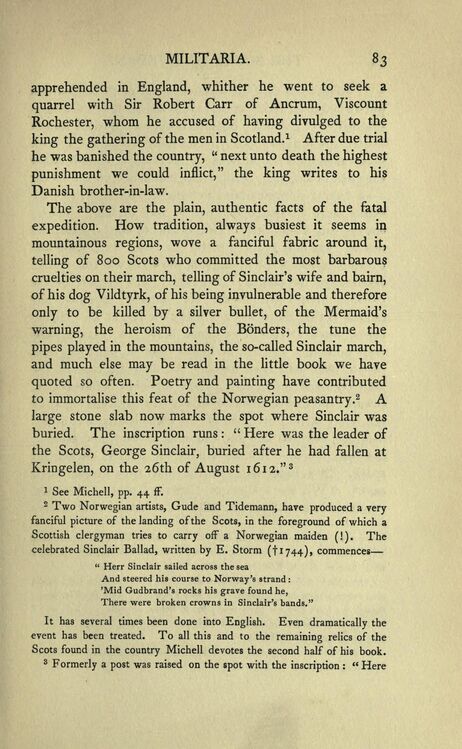
Full resolution (JPEG) - On this page / på denna sida - Sidor ...

<< prev. page << föreg. sida << >> nästa sida >> next page >>
Below is the raw OCR text
from the above scanned image.
Do you see an error? Proofread the page now!
Här nedan syns maskintolkade texten från faksimilbilden ovan.
Ser du något fel? Korrekturläs sidan nu!
This page has never been proofread. / Denna sida har aldrig korrekturlästs.
apprehended in England, whither he went to seek a
quarrel with Sir Robert Carr of Ancrum, Viscount
Rochester, whom he accused of haying divulged to the
king the gathering of the men in Scotland.1 After due trial
he was banished the country, “ next unto death the highest
punishment we could inflict,” the king writes to his
Danish brother-in-law.
The above are the plain, authentic facts of the fatal
expedition. How tradition, always busiest it seems in
mountainous regions, wove a fanciful fabric around it,
telling of 800 Scots who committed the most barbarous
cruelties on their march, telling of Sinclair’s wife and bairn,
of his dog Vildtyrk, of his being invulnerable and therefore
only to be killed by a silver bullet, of the Mermaid’s
warning, the heroism of the Bönders, the tune the
pipes played in the mountains, the so-called Sinclair march,
and much else may be read in the little book we have
quoted so often. Poetry and painting have contributed
to immortalise this feat of the Norwegian peasantry.2 A
large stone slab now marks the spot where Sinclair was
buried. The inscription runs : “ Here was the leader of
the Scots, George Sinclair, buried after he had fallen at
Kringelen, on the 26th of August 1612.”3
1 See Michell, pp. 44 ff.
2 Two Norwegian artists, Gude and Tidemann, have produced a
very-fanciful picture of the landing of the Scots, in the foreground of which a
Scottish clergyman tries to carry off a Norwegian maiden (!). The
celebrated Sinclair Ballad, written by E. Storm (11744), commences—
“ Herr Sinclair sailed across the sea
And steered his course to Norway’s strand:
’Mid Gudbrand’s rocks his grave found he,
There were broken crowns in Sinclair’s bands.”
It has several times been done into English. Even dramatically the
event has been treated. To all this and to the remaining relics of the
Scots found in the country Michell devotes the second half of his book.
3 Formerly a post was raised on the spot with the inscription: “Here
<< prev. page << föreg. sida << >> nästa sida >> next page >>